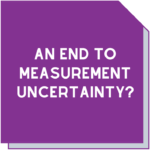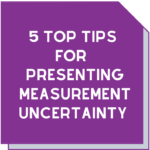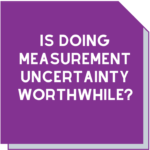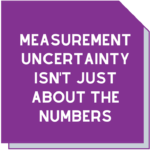50 Shades of….Measurement Uncertainty
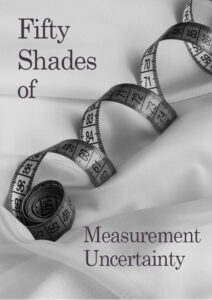 Measurement Uncertainty.
Measurement Uncertainty.
OK, we understand that this isn’t the sexiest of topics.
In fact, it probably isn’t something that makes it through your front door, let alone into the bedroom!
However, if you’re running a lab, Measurement Uncertainty (MU) is something you should know about in all its shades of grey.
Let’s take a look at how to make your MU journey a little less painful.
True confession
You should know up front that we have an excellent training workshop that delivers everything you need to meet NATA’s requirements. It can be extended to different analytical techniques and types of testing and calibration and used to make decisions about:
- Targeting competency assessments
- Conducting equipment checks in-house or sending out for calibration
- Purchasing new equipment
- Improving method performance
By developing an appropriate strategy, you can learn how to meet NATA’s requirements on equipment assurance, in-house calibration, and equipment verification.
You don’t have to do the training course but if you need some help to untangle yourself, this is the perfect way to do it. If you want to skip ahead to the good part, you can just go ahead and book right here.
Earlier this year we published a document on our Resources page with our top 10 tips for MU. You can head over there to download the full document but here are some highlights for you:
Size doesn’t matter
Your MU doesn’t need to be perfect, and it doesn’t have to be ridiculously small; it just needs to be fit for purpose.
Essentially it can be your ‘best guess’ if that is what you have to work with at the start and you can build from there.
Doing Measurement Uncertainty is too hard
Many people approach MU with trepidation because, you know, maths. It might look daunting at the start but it’s important to remember that YOU are the expert in your lab. You do know some ‘stuff’ and that knowledge is important and valuable – and not just for MU.
Also your should consider the consequences for your lab if you don’t carry out MU.
Get yourself ready
Like any process in your lab, you should prepare for calculating MU by gathering all the information you’ll need. That includes your method or procedure. Don’t skip what’s happening in your calibration or testing processes.
Questions you could ask yourself to help with this part of the process include – what am I measuring? how will I measure it? what method will I use? what equipment will I need?
Good looks don’t count
It’s not about the look, it’s about the result. You may want your final Measurement Uncertainty report to look a certain way to impress the auditors. However, consider whether you really need to use your hard-earned funds to buy commercial software to make your report look pretty.
An excel spreadsheet can do exactly what you need without the additional expense. You can add the colours and fancy formatting later.
We all have assumptions
However, when it comes to MU, don’t keep them to yourself. You really need to write them down.
These details explain to an auditor, or anyone that comes after you in your organisation, what you have assumed to be true and what you don’t know. It also helps to demonstrate what you do know to your external auditors.
I’ve done it – now what?
Great work! Now you need to report it. A typical Measurement Uncertainty report should have six primary elements. These are:
- Method title
- Author
- Date
- Identification of uncertainty sources
- Associated raw data used to calculate uncertainty such as information in other spreadsheets. You should reference where the raw data can be found
- Calculation of combined uncertainty and expanded uncertainty. This can be easily completed using a spreadsheet and the report kept with the method validation report.
Use this information on MU and your method validation report to help identify critical points in your method that need to be controlled and the calibration assurance program required to deliver appropriate quality results to your customers.
Shameless promotion
As we said at the beginning, we have an excellent training course that is a must attend for all things MU. There’s no shame in knowing you need help to solve the MU puzzle.
You can read more about the course on our training page.
Why is our course different? Because we follow up with participants two weeks after the course. This is to ensure they’re confident and comfortable carrying out MU back in their lab. Nobody else does this and our participants have all found it incredibly useful.
And as always, we’re just an email away at info@masmanagementsystems.com.au.
Download the 50 shades of Measurement Uncertainty article


